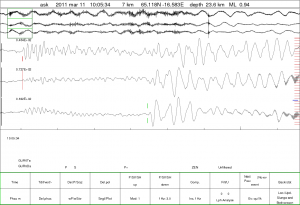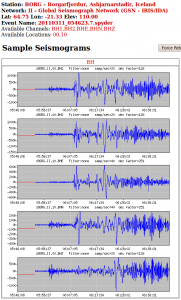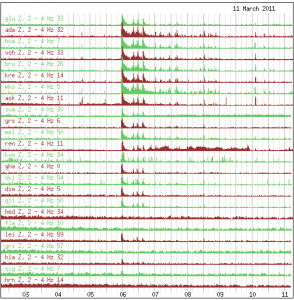I see that in last week (week 10) that there was a deep earthquake swarm that took place under Askja volcano. This time around the earthquake swarm lasted for about 75 seconds and the depth of this earthquake swarm was about 20 km. The location of the earthquakes was north-east of the main Askja caldera, but within the Askja volcano system it self. The largest earthquake last week in Askja volcano was ML2.2 in size. Last year there was also a deep earthquake swarm in Askja. But that time around it lasted for few hours, not second. That activity took place in Week 09 of the year 2010. Here is a map of that weeks activity. But this deep earthquake swarm suggests that magma is on the move under Askja volcano, as was the case in the year 2010 when a similar event did happen.
Above: Picture of the Vatnajökull glacier area. The deep earthquakes north-east of Askja volcano can be seen here.
Above: The 75 second earthquake swarm north-east of Askja volcano.
Japan Mw9.0 earthquake
Strong earthquakes like the Mw9.0 earthquake in Japan appear all over the world on seismometers. In fact the effect from this earthquake could be seen up to five days at least on long period seismometers. Icelandic Met Office did release in last week overview.
Above: How the earthquake did appear on the IRIS seismometer in Iceland.
Above: This is how the earthquake did appear on the SIL network. Aftershocks can also been seen in this plot.
Copyright of this pictures in this blog post belong to Icelandic Met Office or other parties unless I notice otherwise.
Blog post updated at 21:57 CET on 16.02.2011.





Well, that kind of leads to a question. Dunno if any of your sources can answer it.
Extremely sensitive circuits typically employ an automatic gain control in order to keep the gear from becoming saturated and loosing all of the incoming data. Does this apply to seismographic equipment, and did the Japan quake and the large energy release, which did echo for quite some time… have any effect on the detection of smaller quakes in the region?
Seismometers just get saturated. There gain is not changed when big event happens.
There is a nice animation of the seismic activity in japan: http://geofon.gfz-potsdam.de/geofon/alerts/gfz2011ewla/animation_h600.gif
wooooooooo hoooooo, so it wasn’t ice quakes it was Askja waking up!!!!!!
😛
EMSC has a good article on the Mw9.0 earthquake in Japan.
http://www.emsc-csem.org/Page/index.php?id=196
The quake near Katla (MW 2,4 at 1.1 km) is probably an icequake? Temperatures between -10 and -12 degrees C. in the environment (according to Icelandic MET).
Henk Weijerstrass
ZWAAG
M2.4 is a bit much for an ice-induced quake, however it still has to be reviewed and I expect it to drop in size, which makes an ice-quake possible.
What is interesting though is the very small increase in earthquakes within Katla’s caldera, at relatively large depth. (3-8km, and even one 18km deep)
This earthquake activity increase in Katla volcano is worrying in my opinion. Due to how early it is starting. But so far it has not gone above background level for Katla volcano. For now anyway.
What do you mean with ‘early’?
This activity normally happens in August to October when the Mýrdalsjökull glacier is thin after the summer. Now it is at it’s most and thickest.
Isn’t that only applicable for the Godabunga area? I didn’t notice any significant increase in activity in the central caldera this fall/summer
Goðabunga area in Mýrdalsjökull volcano (Katla) is always high in activity. But it has increased activity in the past few years. But that area also has high and low activity depending if it is a summer or a winter time.
But activity in the caldera is normally low. But there are sometimes earthquakes there. But so far this activity is not above background levels. It remains to be seen if that changes.
A minor off-topic notice. I am reconsidering Google Adsense (if they allow me) ads on this web page. As I need to increase my income somehow.
As an off topic, I’m visiting Iceland on vacation for the next 2 weeks! I’m planning to visit Eyjafjallajökull of course and will check out the geothermal areas near Krýsuvík as well. But if there’s something anyone here might like to see I have some days unplanned and might make an excursion. Or if there’s something that is an absolute must-see while I’m there, let me know!
You just have to see the Torfajökull/Landmannalaugar area, it’s beautifull, coloured mountains, many hot springs and a quite large caldera.
Its winter in Iceland. This area is completely covered with snow, so first you need a superjeep (and the experience with it) to access the area and then you will “only” see white mountains.
Oh oops, true, forgot about that hehe!
What are your plans for the trip?
Keep an eye on the weather, since this can turn so bad overnight that roads get closed.
Or, what we find maybe more beautiful then Landmannalaugar: Kerlingarfjöll (speaking of coloured mountains). Walking there is like walking on another planet! And there are many walking paths; ever path showing amazing views of mother nature!
Coming from the north on the Kjöller you pass the junction to Hveravellir and I thought a 20 or 30 km further on you get the junction to Kerlingarfjöll. From there on it’s 10 km to Kerlingarföll. The whole route is bridged, so you can visit Kerlingafjöll with every car (as well as the Kjöller highlandroute).
Have a nice holiday with good weather!
Henk Weijerstrass
ZWAAG
Holland
Once again: It is winter here in Iceland and we had quite a lot of snow in the whole country during the last week. The highlands are completely inaccessible unless you own a superjeep and have the experience to drive in this area. And have some company of another car like this, since its not a good idea to visit this areas alone.
One more tip: Check the road conditions and take it serious. Krýsuvik hasn’t been accessible during the last days due to snowfall and snowdrift.
http://www.vegagerdin.is/english/road-conditions-and-weather/the-entire-country/island1e.html
Nice site for nature photography in Iceland in case you don’t already have. Take a nice camera for sure.
http://www.islandhanomag.de/index.htm
Thanks everyone for the replies. I’m in Iceland now, it’s very beautiful and a nice place with a lot of nice people. Kleinur is delicious.
We are staying in Reykjavik area this week to see the sights, with a trip to Blue Lagoon and hopefully Krýsuvík geothermal areas and a Golden Circle tour. If they’re accessible of course. The following week we take a superjeep to Eyjafjallajökull and maybe go to Vík for a day and to Jökulsárlón. If the weather permits.
I keep hoping sunspot 1175 will do something and make some nice aurora, but nothing yet. And I probably will miss the supermoon tonight due to clouds, but maybe it will peek through.
Beautiful moon? lit view of Katla right now!
http://www.ruv.is/katla
I am living in Iceland so I can advice you with this.
You can do the golden circle, visit the blue lagoon, visit the Eyjafjallajokull, Katla and Vik area from the seaside (worth for a whole day), if you have extra days you can travel to Snaefellsnes peninsula, there is much to see there, 2 or 3 days would be best. And with more time you could travel to Myvatn in the area, much to see there as well. Krisuvik area is close to Reykjavik and Blue lagoon, but I dont know of any bus to there. Expect bad weather and cold for your trips. Take care hiking, it can be dangerous and deadly in winter. Landmannalaugar, Thorsmork, and the highlands are closed at this time of year. Its crazy thinking of going now there. At the moment, all the country is covered with snow, but closer to sea, it often melts with rain and then covers again. Remember to watch out the skies with patience, northern lights can come out of nowhere and suddenly. Follow spaceweather.com and en.vedur.is
There is no bus to Krysuvik. You have to have a car to get there as well as road conditions, which allow this.
Another deep quake at Katla – but this needs to be reviewed, since the quality is quite low.
Earthquake in Esjufjöll volcano. This normally means that a earthquake swarm is starting in them. But it might take few more hours until it gets started.
Interesting.
Today there was an earthquake in Geysir area
Another in Torfajokull caldera
Further east, another in Veidivotn (Bardarbunga fissure, northwest of Laki)
Also a few in Bardarbunga and Grimsvotn calderas
Another in Esjufjoll
And another south of Vatnajokull, on the sea, but curiously it forms a line with all the other Vatnajokull quakes (might be a coincidence, or might be not)
And a small swarm in Katla caldera
Any thoughts?
I have noticed that these sporatic deeper quakes around the Katla have picked up a little in the last 3 months, but I think this latest round has a little higher spatial frequency. At some point, if this continues to pick up it would be interesting to see a 1 year plot with depth.
Umm… Okay.
http://i55.tinypic.com/24fe61v.png
Thanks! Now can you color code with yellow all the ice cap related quakes (as the icecap varies positionally), remove the frost quakes or where quality was below 80, expand time out to 2 years, use a 4 color coding scheme to show which quadrant each quake lies in related to the caldera, use different sized dots to show the magnitude (this will require a larger format) and add some fries and coke that’ll do it.
Can someone explain the interesting lull in activity around March-May 2010, Eyjafjallajökull eruption sucking up the nearby pressure?
I wouldn’t say “sucking up the pressure”… more like providing a relief for it.
Reminds me of a person that I knew who was deathly afraid of my antennas. I had told him that there was nothing to worry about unless we had an inbound missile since that was about the only time that we would go “full on.” One day I found him studying an electronics course, which he passed. He still wouldn’t go near my antennas. I asked why, seeing as he now knew the difference between passive and active operations. He stated that it was because in receive only mode, they were “sucking in” all that RF energy.
So… terminology does matter. 😀
As for color coding… gimme a way to numerically differentiate which is which and I’ll give it a go.
I guess you get my warped humor at this point re: all the plot enhancements, after all you do have a day job 🙂 I had a manager who did that to me all the time with data mining reports, drove me crazy.
In my term, sucking up pressure, I actually did mean what you said – pressure relief. The sucking part was not literal 🙂
The plot is interesting in the way it shows the transition from the summer melting months but I am interested in what others might glean from this. I think I would have to see a longer time plot to see any uptick in activity the year prior to Eyjafjallajökull eruption.
Just random earthquakes happening in Iceland.
The Rachel Maddow blog has posted a LIDO (Listening to the Deep Ocean) sound recording of the Japanese earthquake and its aftershocks. You can find it here:
http://maddowblog.msnbc.msn.com/
thanks for the link : ) it seems like i’m not the only one hwo likes rachels show : )
M2.8 in southren Finland. It was felt pretty widely…
Finland is doomed I tell you… DOOOOOMED!!
That’s the energy equivalent of 666 Cheeseburgers.
Reminds me of Frazer of Dad’s army (comedyserie); he also said “dooooooooomed”!
Note to Jack @ Finland,
Nothing untoward was intended. It’s just that the cheeseburger number jumped out at me. The evil mark of the McDonald’s… the anti-Gyro incarnate. The demonic fast-food purveyor of greasy sliders and dubious bread.
Got it. :o)
I felt it – it was about 20 km from where I live.
My first thought was that is was snow coming down from the roof, but our roof material does not shed snow like that, so the second idea was, \Did somebody hit the wall with a car?\
It was the second quake I’ve felt in my life.
For me the only one is 1985 or 1986, while I was at school. It was a M2-M3, and it lasted a few seconds. I did not feel this one, but my friends living closer to epicentre did feel it.
Nothing happening in Iceland? Blog quiet
Today is Eyjafjallajökul (Fimmvorduháls) eruption anniversary.
Congrats to us all!
Here is detailed information of the Mw 9.0 quake in Japan:
Interesting video of how Japan moves during the quake.
http://gps.alaska.edu/ronni/sendai2011.html
Whats gonna be interesting… is to see what come next.
On one hand, that’s quite a bit of stress that has been unloaded on the northern reached of that subduction zone, with quite a bit of energy release north of there in the late ’60s. (≈1968 time frame in the southern Kuril trench). Will this load the southern part of the zone or even the region south of the triple junction? Possibly affect the Nankai trough?
There is a tendency for Japan’s large ones to be repeat performers. Based on my non-expert analysis, there may be a 6 to 9 month repeat signal in the large Japanese quakes.
But… looking at it another way, did the 9.0 “get it out of it’s system” and herald a quiet time? The energy release of that one quake, at about 1.99526E+18 Joules, was almost the same as all the Mag 6.5 and higher quakes in the area from 1897 to 1920, 2.67747E+18 Joules. And that’s not counting the aftershocks. Of course, the “Great Kanto” quake wasn’t counted either (1923 and outside the faulting area of the 9.0).
Dunno. In my reckoning, it could go either way.